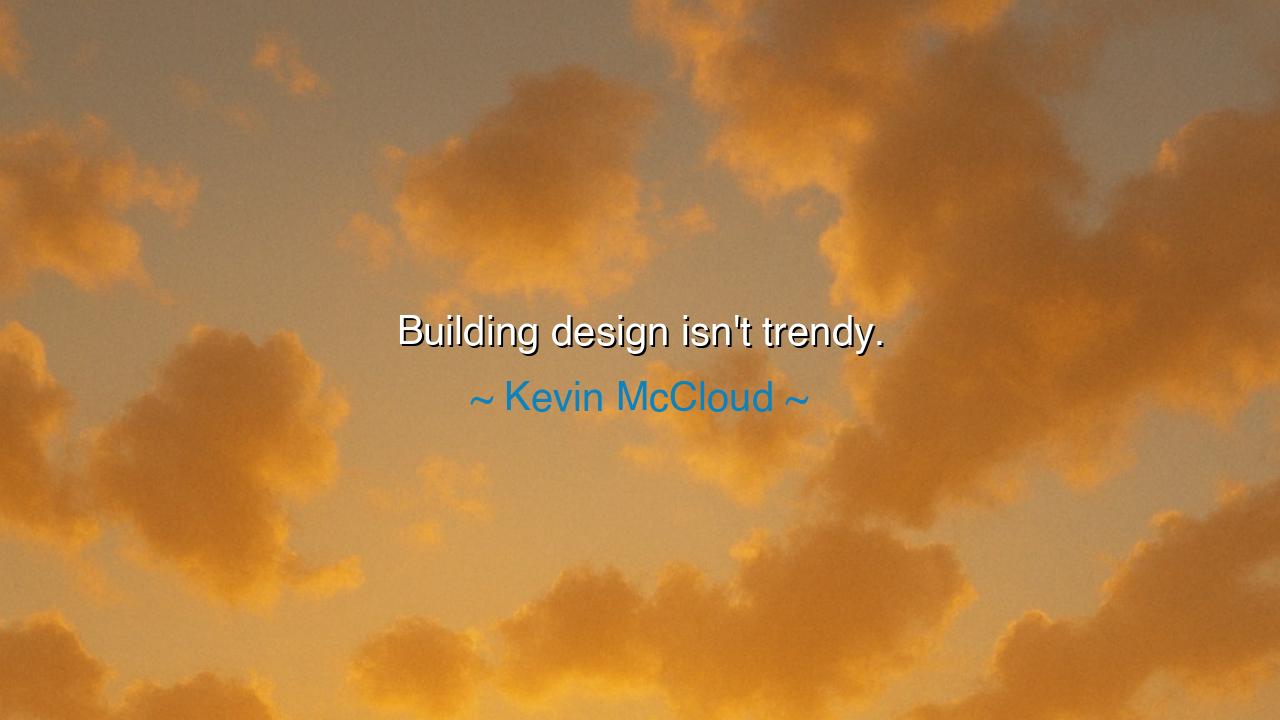
Building design isn't trendy.






“Building design isn’t trendy.” Thus spoke Kevin McCloud, the thoughtful voice behind Grand Designs and a philosopher of modern architecture, though few might call him that. In this short, almost understated phrase lies a wisdom that stretches far beyond the craft of building—it is a truth about endurance, purpose, and time itself. To say that building design “isn’t trendy” is to declare that true creation—creation meant to last—is not born from fashion or fleeting desire, but from vision, integrity, and understanding of the human soul. For trend is temporary, but design is eternal.
McCloud’s words rise from the long lineage of builders who understood that what they shaped in stone, wood, and light would outlive them. The architect who builds for trend seeks applause today; the one who builds for truth seeks reverence tomorrow. To him, design is not a costume to be worn for a season, but a covenant between past and future—a promise to those yet unborn that what is built will endure, will shelter, will uplift. The ancients knew this. The Parthenon, the Gothic cathedrals, the temples of Angkor—none were made for the moment; they were made for eternity. Every column, every arch, was a prayer carved into matter, testifying to the timeless. So when McCloud speaks, he echoes the wisdom of centuries: the call to build not for fashion, but for forever.
In our age of haste, where novelty is praised above meaning, his statement becomes a kind of quiet rebellion. The modern world celebrates the temporary—the glass tower that dazzles but soon dates, the interiors remade every decade, the facades that age before their mortar dries. Yet McCloud reminds us that architecture is a moral act, not a trend. A building is not merely an object; it is a home for human lives, a landscape of memory. When a designer bows to trend, they betray both form and function, creating not sanctuaries but spectacles. To build well, to design with purpose, is to resist the vanity of the moment and to serve the enduring needs of humanity—beauty, belonging, and meaning.
Consider the enduring lesson of Frank Lloyd Wright, whose Fallingwater remains one of the most beloved buildings of the modern age. When Wright designed it in the 1930s, he ignored the fashionable styles of his time. Instead, he listened—to the waterfall, to the rock, to the forest that embraced the house. He built not to impress but to harmonize, allowing architecture to serve nature rather than dominate it. Nearly a century later, Fallingwater stands not as a relic of its era, but as something ageless, alive. It breathes the truth of McCloud’s words: that design rooted in understanding, not in trend, becomes eternal art.
McCloud’s statement also carries a deeper, almost spiritual undercurrent. For “building design” is not only about walls and roofs—it is also about the architecture of our own lives. To live “trendy” is to chase shadows; to live “designed” is to build upon principles that do not fade. The life founded on fashion collapses when the wind changes, but the life built upon purpose—like the building constructed upon bedrock—stands through the tempests of time. Thus, the wisdom of the builder becomes the wisdom of the soul: build your life not for applause, but for endurance; not for attention, but for legacy.
In this way, McCloud speaks not just to architects, but to all who create. Whether one builds houses or families, careers or communities, the principle is the same: what is made with thought, integrity, and patience will endure. What is made in haste for fashion will vanish like dust. Every generation must decide whether it will leave ruins or monuments, noise or harmony. The builders of lasting beauty—be they architects, artists, or thinkers—always choose timelessness over trend.
So let this teaching be remembered: do not build for the moment; build for the centuries. When you create, let your work serve something greater than yourself. Let it breathe humanity, honesty, and purpose. For the fleeting will perish with the wind, but what is true will stand as a testament long after your name is forgotten. Just as the stones of ancient temples still whisper the prayers of their makers, so too will your work, your choices, and your life speak—if only you build them upon foundations that time cannot erode.
And thus, when Kevin McCloud tells us that “building design isn’t trendy,” he is not simply defending architecture from fashion—he is reminding us of our duty to time itself. To build well, to live well, to create well, is to enter into a covenant with the future. For the works of trend are like sparks that dazzle and die—but the works of design, born of truth and wisdom, are like stars: they burn forever.






AAdministratorAdministrator
Welcome, honored guests. Please leave a comment, we will respond soon